
个人主页: 几分醉意的CSDN博客_传送门
上节我们介绍了什么是AOP、Aspectj框架的前置通知@Before传送门,这篇文章将继续详解Aspectj框架的其它注解。
文章目录
?Aspectj框架介绍✨JoinPoint通知方法的参数✨后置通知@AfterReturning✨环绕通知@Around✨异常通知@AfterTrowing✨@Pointcut定义和管理切入点注解✨总结 ?投票传送门(欢迎伙伴们投票)
?Aspectj框架介绍
AOP技术思想的实现:使用框架实现AOP。实现AOP的框架有很多。有名的两个
1. Spring:Spring框架实现AOP思想中的部分功能。Spring框架实现AOP的操作比较繁琐,笨重。
2. Aspectj:独立的框架,专门做AOp的,功能最强大的。属于Eclipse。
而我下面主要介绍的就是Aspectj框架来实现Aop,Aspectj框架可以使用注解和xml配置文件两种方式实现AOP。
✨JoinPoint通知方法的参数
切面类中的通知方法,可以有参数,但是必须是JoinPoint。
JoinPoint: 表示正在执行的业务方法。 相当于反射中 Method
使用要求:必须是参数列表的第一个
作用:获取方法执行时的信息,例如方法名称, 方法的参数集合
下面我们直接实战,注意下面用的是上一节的前置通知的业务接口和实现类。
切面类
@Aspectpublic class MyAspect {@Before(value = "execution(* *..SomeServiceImpl.do*(..) )") public void myBefore2(JoinPoint jp){ //获取方法的定义 System.out.println("前置通知中,获取目标方法的定义:"+ jp.getSignature()); System.out.println("前置通知中,获取方法的名称"+jp.getSignature().getName()); //获取方法执行时的参数 Object[] args = jp.getArgs(); //返回的是一个数组 里面存放的是所有参数 for (Object arg : args) { System.out.println("前置通知,获取方法的参数是"+arg); } //切面的代码。 System.out.println("===前置通知,切面的功能,在目标方法之前先执行==:"+new Date()); System.out.println(""); }}测试
@Test public void test(){ //如果没有加入代理的处理: // 1)目标方法执行时,没有切面功能的。 // 2) service对象没有被改变 //加入代理的处理: // 1)目标方法执行时,有切面功能的。 // 2) service对象是改变后的 代理对象 com.sun.proxy.$Proxy8 String s = "applicationContext.xml"; ApplicationContext ctx = new ClassPathXmlApplicationContext(s); SomeService service = (SomeService)ctx.getBean("someService"); service.doSome("ll" , 22); }//JoinPoint:哪个目标对象方法执行时,它就代表哪个方法//例如这里doSome执行时,它就代表doSome,然后可以获取这个方法的信息执行结果:
拓展: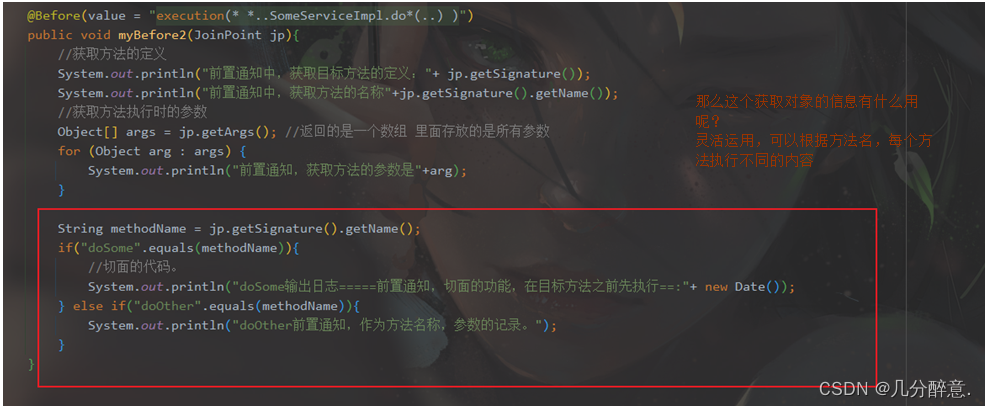
✨后置通知@AfterReturning
* @AfterReturning:后置通知 * 属性:value 切入点表达式 * returning 自定义的变量,表示目标方法的返回值的。 * 自定义变量名称必须和通知方法的形参名一样 * 位置:在方法的上面 * * 特点: * 1.在目标方法之后,执行的。 * 2.能获取到目标方法的执行结果。 * 3.不会影响目标方法的执行 * * 方法的参数: * Object res: 表示目标方法的返回值,使用res接收doOther的调用结果。 * Object res= doOther(); * * 后置通知的执行顺序 * Object res = SomeServiceImpl.doOther(..); 先执行业务方法 * myAfterReturning(res); 在执行后置通知 * * 思考: * 1 doOther方法返回是String ,Integer ,Long等基本类型, * 在后置通知中,修改返回值, 是不会影响目标方法的最后调用结果的。 * 2 doOther返回的结果是对象类型,例如Student。 * 在后置通知方法中,修改这个Student对象的属性值,会不会影响最后调用结果? *下面通过举例的方式,带大家理解后置通知。
首先业务接口添加doOther方法,然后实现它的实现类
public interface SomeService { void doSome(String name,Integer age); String doOther(String name,Integer age);}public class SomeServiceImpl implements SomeService { @Override public void doSome(String name, Integer age) { System.out.println("业务方法doSome(),创建商品订单"); } @Override public String doOther(String name, Integer age) { System.out.println("执行业务方法doOther,处理库存"); return "abcd"; }}创建切面类
@Aspectpublic class MyAspect { //定义方法,表示切面的具体功能 /* 后置通知方法的定义 1)方法是public 2)方法是void 3)方法名称自定义 4)方法有参数,推荐使用Object类型 */ @AfterReturning(value = "execution(* *..SomeServiceImpl.doOther(..))", returning = "res") public void myAfterReturning(JoinPoint jp , Object res){ System.out.println("后置通知,在目标方法之后,执行的。能拿到执行结果:"+res); //修改目标方法的返回值 if(res != null){ res = "HELLO Aspectj"; } System.out.println("后置通知,修改res后"+res); }}测试:
@Test public void test02(){ String config="applicationContext.xml"; ApplicationContext ctx = new ClassPathXmlApplicationContext(config); SomeService service = (SomeService) ctx.getBean("someService"); String ret = service.doOther("zhangsan", 20); System.out.println("test02中调用目标方法的结果:"+ret); }执行结果:
✨环绕通知@Around
特点介绍: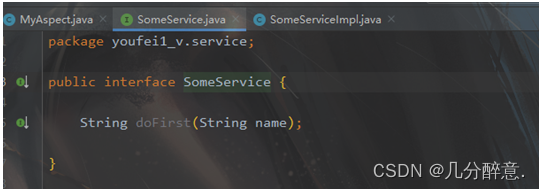
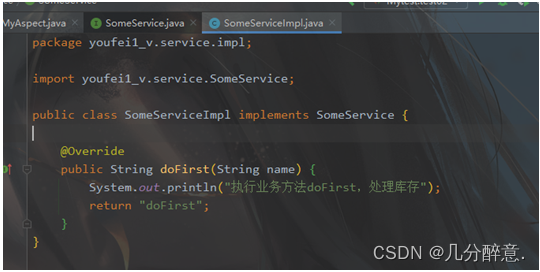
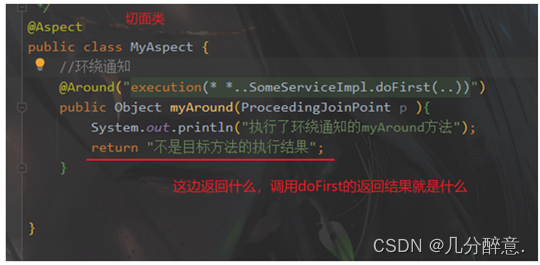

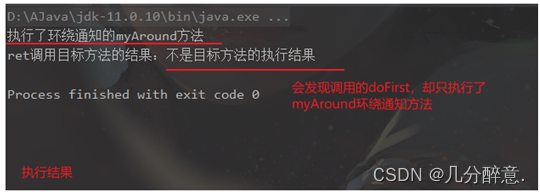

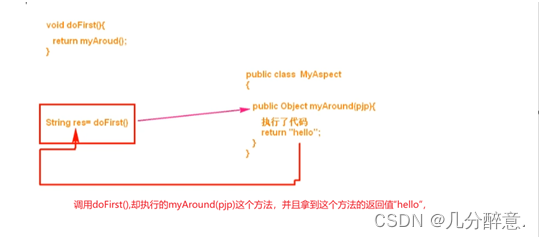
* @Around:环绕通知 * 属性:value 切入点表达式 * 位置:在方法定义的上面 * * 返回值:Object ,表示调用目标方法希望得到执行结果(不一定是目标方法自己的返回值) * 参数: ProceedingJoinPoint, 相当于反射中 Method。 * 作用:执行目标方法的,等于Method.invoke() * * public interface ProceedingJoinPoint extends JoinPoint {} * * 特点: * 1.在目标方法的前和后都能增强功能 * 2.控制目标方法是否执行 * 3.修改目标方法的执行结果。 *@Aspectpublic class MyAspect { //定义方法,表示切面的具体功能 /* 环绕置通知方法的定义 1)方法是public 2)方法是必须有返回值, 推荐使用Object类型 3)方法名称自定义 4)方法必须有ProceedingJoinPoint参数, */ @Around("execution(* *..SomeServiceImpl.doFirst(..))") public Object myAround(ProceedingJoinPoint pjp) throws Throwable { Object methodReturn = null; System.out.println("执行了环绕通知,在目标方法之前,输出日志时间=="+ new Date()); //执行目标方法 ProceedingJoinPoint,表示doFirst methodReturn = pjp.proceed();//method.invoke(),表示执行doFirst()方法本身 if( methodReturn != null){ methodReturn ="环绕通知中,修改目标方法原来的执行结果"; } System.out.println("环绕通知,在目标方法之后,增加了事务提交功能"); //return "HelloAround,不是目标方法的执行结果"; //返回目标方法执行结果。没有修改的。 return methodReturn; }}测试:
@Test public void test02(){ String config="applicationContext.xml"; ApplicationContext ctx = new ClassPathXmlApplicationContext(config); SomeService service = (SomeService) ctx.getBean("someService"); String ret = service.doFirst("zhangsan"); System.out.println("ret调用目标方法的结果:"+ret); }执行结果:
✨异常通知@AfterTrowing
业务接口和实现类:
public interface SomeService { void doSecond(String name);}@Servicepublic class SomeServiceImpl implements SomeService { @Override public void doSecond(String name) { System.out.println("执行业务方法doSecond,处理库存"+(10/0)); }}切面类:
@Aspectpublic class MyAspect { //定义方法,表示切面的具体功能 /* 异常通知方法的定义 1)方法是public 2)方法是没有返回值。是void 3)方法名称自定义 4)方法有参数是Exception */ /** * @AfterThrowing:异常通知 * 属性: value 切入点表达式 * throwing 自定义变量,表示目标方法抛出的异常。 * 变量名必须和通知方法的形参名一样 * 位置:在方法的上面 * 特点: * 1. 在目标方法抛出异常后执行的, 没有异常不执行 * 2. 能获取到目标方法的异常信息。 * 3. 不是异常处理程序。可以得到发生异常的通知, 可以发送邮件,短信通知开发人员。 * 看做是目标方法的监控程序。 * * 异常通知的执行 * try{ * SomeServiceImpl.doSecond(..) * }catch(Exceptoin e){ * myAfterThrowing(e); * } */ @AfterThrowing(value = "execution(* *..SomeServiceImpl.doSecond(..))",throwing = "ex") public void myAfterThrowing(Exception ex){ System.out.println("异常通知,在目标方法抛出异常时执行的,异常原因是:"+ex.getMessage()); /* 异常发生可以做: 1.记录异常的时间,位置,等信息。 2.发送邮件,短信,通知开发人员 */ }}测试:
@Test public void test01(){ String config="applicationContext.xml"; ApplicationContext ctx = new ClassPathXmlApplicationContext(config); SomeService service = (SomeService) ctx.getBean("someService"); service.doSecond("lisi"); }执行结果:
✨ 最终通知@After
业务接口和实现类:
public interface SomeService { void doThird();}@Servicepublic class SomeServiceImpl implements SomeService { @Override public void doThird() { System.out.println("执行了业务方法doThird()"); }}切面类:
@Aspectpublic class MyAspect { //定义方法,表示切面的具体功能 /* 最终通知方法的定义 1)方法是public 2)方法是没有返回值。是void 3)方法名称自定义 4)方法没有参数 */ /** * @After:最终通知 * 属性: value 切入点表达式 * 位置: 在方法的上面 * 特点: * 1. 在目标方法之后执行的。 * 2. 总是会被执行。 * 3. 可以用来做程序最后的收尾工作。例如清除临时数据,变量。 清理内存 * * 最终通知 * try{ * SomeServiceImpl.doThird(..) * }finally{ * myAfter() * } */ @After(value = "execution(* *..SomeServiceImpl.doThird(..))") public void myAfter(){ System.out.println("最终通知,总是会被执行的"); }}测试:
@Test public void test01(){ String config="applicationContext.xml"; ApplicationContext ctx = new ClassPathXmlApplicationContext(config); SomeService service = (SomeService) ctx.getBean("someService"); service.doThird(); }执行结果:
✨@Pointcut定义和管理切入点注解
@Aspectpublic class MyAspect { @Before(value = "mypt()") public void myBefore(){ System.out.println("前置通知,在目标方法之前先执行的"); } @After(value = "mypt()") public void myAfter(){ System.out.println("最终通知,总是会被执行的"); } /** * @Pointcut: 定义和管理切入点,不是通知注解。 * 属性: value 切入点表达式 * 位置: 在一个自定义方法的上面, 这个方法看做是切入点表达式的别名。 * 其他的通知注解中,可以使用方法名称,就表示使用这个切入点表达式了 */ @Pointcut("execution(* *..SomeServiceImpl.doThird(..))") private void mypt(){ //无需代码 }}✨总结
AOP是一种动态的技术思想,目的是实现业务功能和非业务功能的解耦合。业务功能是独立的模块,其他功能也是独立的模块。例如事务功能,日志等等。让这些事务,日志功能是可以被复用的。
当目标方法需要一些功能时,可以在不修改,不能修改源代码的情况下,使用aop技术在程序执行期间,生成代理对象,通过代理执行业务方法,同时增加功能。